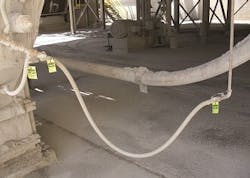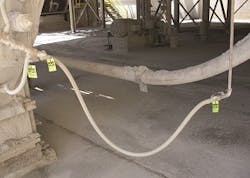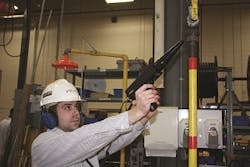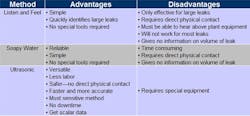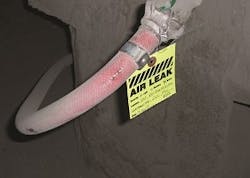Back to basics: Getting to the bottom of leaks in your compressed air system
Leaks happen. There is quite simply no way around it. They’re in every compressed air system. Even in systems with the newest pipe and the most energy-efficient and most technologically advanced compressors. Due to material thermal stresses, leaks will appear, costing you money. Possibly a lot of money. While it’s sometimes impractical to eliminate them completely, it’s possible to manage them and greatly reduce their impact on your operating costs. Having a program to find, tag, and fix compressed air leaks will keep them in check, prolong equipment life, and add money back to your bottom line. Here’s how.
Begin with buy-in
Many companies make the mistake of starting with a leak-detection audit, but, unless you control all the resources needed to find, tag, and repair the leaks, you need to start with getting buy-in for establishing a sustainable leak-reduction program from those who do. If there is no buy-in, there will be no follow-through. Without buy-in, you will find yourself with a completed leak-detection audit, a list of leaks, and not much else. This is where so many plants fall short. They pay for the audit and tag the leaks, but never fix them. The tags remain attached to the leaks, fade, or get covered in dust, and over time people stop noticing them, or worse they are hastily removed before a high-level plant inspection. Meanwhile, the same existing leaks may worsen as new ones develop.
If, however, you begin by getting everyone on board with a leak-reduction program rather than a leak detection audit, you will have a better chance of successfully managing the leaks and proactively contributing to your plant’s ongoing energy efficiency efforts.
Money talks. Use it to convince colleagues and upper management to back your leak-reduction program. Some managers acknowledge they have leaks but assume they aren’t worth the time and money to fix, given other priorities. But until you get at least a solid estimate of your leak situation, you can’t make an informed decision. The true benefit comes from setting a baseline, following up with leak detections, and making subsequent repairs.
Figure 1. According to Compressed Air Challenge of the U.S. Department of Energy’s Office of Industrial Technologies, the total cost of 100 psig compressed air has been calculated to be between $0.18/1,000 ft3 and $0.32/1,000 ft3. Fixing a single small leak in a plant quickly pays for itself. (Source: Compressed Air Challenge)
Figure 2. Leaks commonly occur in hoses and fittings.
While you may not know how much money you are losing each month to leaks, you can make the point by sharing the cost of a single leak (Figure 1). Then point out that leaks are very common. They can occur at every connection from the compressor discharge flange, in dryers and filters, throughout the distribution piping, and on down to the point of use at the FRLs and fittings on the production equipment. Hoses and quick-release fittings are notorious for leaks. So are underground air pipes. Some of the largest leaks are within the production equipment. We’ve seen annual leak losses from $3,000 in a small system to more than $600,000 in large systems. Individual leaks are commonly between $200 and $1,200, but some are much worse (Figure 2).
Finally, point out how much you are paying for power to run the compressors. If you don’t know how much you are paying to run your compressors, you can calculate it:
Compressor input power (kW) x Operating Hours x Energy Cost ($/kWh)
And if you want to know how to calculate the cost of a particular leak for your system, here is the formula:
Leak Rate (cfm) x System Efficiency (kW/cfm) x Operating Hours x Energy Cost ($/kWh)
For many, this will be enough to get the support you need. If not, consider that the U.S. Department of Energy estimates that as much as 25% of all compressed air is wasted through leaks; we’ve seen worse. If possible, take a stroll through the plant when you are not in production and listen — do you hear hissing? If you can hear a leak, you should immediately fix it. It’s that simple.
Are the compressors running when you are not in production? This is another sign of leaks, even if you cannot hear them. Note how many hours they run when they shouldn’t be.
Numerous companies with plans to expand their plant operations have been able to avoid capital expenses simply by fixing their leaks and relying on their existing compressor equipment. So you should definitely assess your leaks before buying more/larger compressors to meet new demand. Another point to make is that more leaks mean more compressor run time, which has cost implications for parts and service in addition to energy. After you have buy-in, you can move forward with getting a thorough leak-detection audit.
Find your “leakness”
Figure 3. Ultrasonic leak detection is safe and convenient, and it gives concrete data on the leak volume.
There are different methods for leak detection, each with advantages and disadvantages, and each method has a place in an ongoing leak-reduction program. Your hearing, sight, and sense of touch may help clue you in to the fact that you have leaks, but they are limited. For the purposes of gathering concrete, measurable data that you can use to help you prioritize how you want to fix the leaks, ultrasonic leak detection is the most effective.
Ultrasonic leak detection is the industry standard because it is fast and accurate, and it can detect leaks far better than human senses. No physical contact or plant downtime is required, so it is safe and convenient. This method works because, when compressed air is released into the atmosphere, the turbulence creates ultrasonic noise, which is usually inaudible to the human ear, but detectable with the right equipment. Ultrasonic leak detection equipment typically consists of directional microphones, amplifiers, and audio filters, and it usually has either visual indicators or earphones to help the auditor to identify the leaks (Figure 3).
Since ultrasonic is a high-frequency signal, the sound from a compressed air leak is both directional and localized to the source. This allows the ultrasonic detector to sense the leak even in loud, noisy environments and to pinpoint the source. Some ultrasonic devices are also able to estimate and record the magnitude of each leak based on its sound. The logged data can then be downloaded to a spreadsheet for reporting analysis and prioritizing repair efforts (Figure 4).
Figure 4. Of the three methods for leak detection, ultrasonic is the industry standard. The other two methods, however, can still be helpful tools in your ongoing leak management efforts.
When selecting an ultrasonic leak auditor, remember that not all are equal. A good leak detection auditor should:
- be well prepared and have the tools, experience, and the credentials to work in your plant
- clearly identify each leak with an easily recognized tag that includes the date and a unique identifying code/number
- provide a list of leaks with each one’s location, unique identifier, and magnitude
- estimate the cost/potential savings of each leak and enable you to sort the list by leak severity.
Ask to see a sample report so you will know what to expect at the end of your audit. Since this is the data you’ll be using to implement your comprehensive leak-reduction program, the report should be thorough, user-friendly, and should prioritize the leaks to give you a clear picture of the leak situation in your plant. The estimated cost savings included is something to share with upper-level management to help strengthen their buy-in for the repairs you’ll be recommending.
Tag it
Whether you do it in-house or hire a leak auditor to do it, you want to physically tag each leak, for three reasons:
- to make it easy to find the leaks during the repair phase
- to remind you and your staff the leak is still there
- to send the message to all that eliminating waste is a priority, but this only works if the leaks get fixed (Figure 5).
Figure 5. Use a physical tag to clearly label each leak in your plant.
Prioritize and repair
Once you have the audit report that lists each leak, location, and severity, it’s time to develop a plan for prioritizing and repairing them. If you have any leaks that pose a safety hazard or could cause any kind of failure or breakdown or lead to production downtime, fix those immediately. Then sort the list by magnitude and start with the worst. You might find that leaks may follow the 80/20 rule — that is, 80% of the leakage occurs in 20% of the leaks. A good goal would be to have those completed within one to two weeks. Within the next three to four months, address the next largest leaks that still account for a significant loss, but not the top 20%. Finally, all of the remaining small leaks should be monitored on a regular basis and repaired if they worsen.
Leaks recur, so plan to repeat the process. The time between audits should depend on the severity of leakage found in the initial audit. If you found a lot of leaks or at least several major leaks, you should schedule the second audit sooner rather than later. Frequency of the subsequent audits should be based on the savings realized in leak repair versus the opportunity costs of not doing something else that generates more savings or increased revenue for the same cost and effort.
Be sure to inform all concerned about the savings realized to keep the program going. Educate your employees on what you expect them to do if they suspect or find a leak. Develop guidelines for classifying a leak as small, medium, or large, once an employee finds one and have the employee tag it. Some plants have an incentive program where employees are rewarded for finding leaks and, even more important, taking initiative to fix them. Having everyone on the lookout is the best way to keep the leaks under control.
Long-term success
After eliminating the majority of the leaks in your system, consider having a more comprehensive compressed air system audit. Now that you have eliminated wasted air, an audit will indicate if your system is operating at a higher pressure than necessary, is oversized, needs better controls, or presents other areas for optimization. Leak detection and compressed air audits go hand in hand for ongoing energy management. Leaks happen, but how you manage them can have a huge impact on your bottom line.
